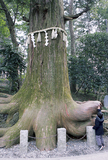
 Buddhists at the Yakuoin temple in Hachioji city in western Tokyo walk barefoot on embers during a ceremony held in March festival at the foot of Mt. Takao. Hundreds of people followed the monks and participated in the ceremony to purify their mind and body, also to play for good health and safety.
Buddhists at the Yakuoin temple in Hachioji city in western Tokyo walk barefoot on embers during a ceremony held in March festival at the foot of Mt. Takao. Hundreds of people followed the monks and participated in the ceremony to purify their mind and body, also to play for good health and safety.
Mt. Takao Fire Walk Ceremony 高尾山 火渡りまつり
Yakuoin Temple at the top of Takao At one of the taikais, a yamabushi’s costume was displayed in the tea room of the Tokyo Budokan. At Takao, yamabushi, practioners of 修験道, shugendo, have been doing ascetic rites for over 1000 years. Enshrined in Yakuoin Temple at the top of Takao is Izuna Gongen, a fierce-looking, beaked man wearing the shugensha’s costume and bearing a sword. His cult originated at Togakushi. So many expressions of Japanese religiousity and esoteric practices are deeply syncretic; the mountain asceticism combines old Shinto practice, Shingon Buddhism, and Taoism. At Yakuoin Temple, if you have the time to take in the tapestry of symbolism and sacred words decorating the statuary, temple buildings and the mountain itself, there are so many messages from these traditions. In the Shinto vein, the Shugendo practioners honor the natural cycle, and in the Buddhist practice of letting go of things that hinder you on the path, they mark the early spring with a ritual to burn away attachments and evil in the form of 火渡り, fire walking. The ritual, attended by thousands of people, priests, monks and nuns, weekend shugensha in white ritual garb, young people, old ladies, lasted a few hours. The chanting of the Heart Sutra (I like Alan Ginsberg’s translation of the Japanese version) and various mantra, including the Fudomyo mantra, continued as the fire burned, and the monks crossed on the glowing embers barefoot, followed by the throng. When we took our turn, the monks and nuns were chanting as fervently as at the beginning, and the ashes were still warm. Guided and protected by the monks, we stood in salt before and after the crossing, and then knelt to be invested with fire from the head priest. So many symbols and meanings came to me as we were participating. Salt is used to ritually purify in many cultures, but especially in Japan, it’s used to negate bad luck that might follow after a death or funeral, and little piles of salt are placed at the doors of businesses and houses to keep evil out. To my mind, we died a bit there, crossing the fire. I think some of the baggage got sloughed off. I feel lighter now. And I felt really cared for by the monks. They are present for each person as they emerge from that Fudo-fire. I’ve been looking for an explanation of the meaning of the Fudomyo mantra, “Noomakusaa mandabaa zaradansen damaka roshada sowataya untara takanman,” for some time, but as yet have not found an English translation of the orginal Sanskrit. So for now, I’m satisfied to chant it and as I do so, think about all that Fudomyo embodies. VIA |
View blog reactions

















0 Comments:
Post a Comment